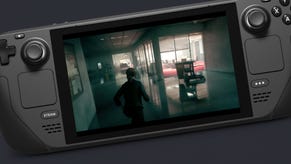Cyberpunk 2077's fascinating afterlife
V rising.
This article originally went out to Eurogamer supporters as part of the Eurogamer Essentials newsletter that goes to all members every Friday. If you'd like to find out how to become a Eurogamer supporter you can find out more here.
If' there's anything as fascinating is the incubation of a triple-A game - something exposed in spectacular fashion last weekend by the GTA 6 drama, with leaks that stripped away the gloss and exposed the wheels and cogs (as well as the ignorance of how exactly video games are made, something we could all do a better job of educating each other on) - it's the afterlife of a modern-day blockbuster. Even better when it's one as derided as Cyberpunk 2077 was at launch.
Why exactly CD Projekt's sci-fi spectacular was the subject of such ire when it launched at the tail-end of 2020 is a topic too multifaceted to properly unpick with the 600 or so words we have here; there was some righteous anger about the appalling working conditions Cyberpunk 2077 was made under at times, a hype cycle that even the most accomplished of games would buckle under, a more than messy launch as it awkwardly straddled two generations of hardware and, ultimately, a good old-fashioned pile-on that obscured all else. There’s rarely room for nuance in internet discourse, and the noise around Cyberpunk 2077’s launch is proof perfect of that.
Apologies for blowing our own trumpet, but I was and remain immensely proud of Chris Tapsell’s review for us which managed to toe a line between all that chaos, drawing no small amount of ire himself for putting a Recommended badge on a game deemed to be an affront to so many. Games are vast, complex things, pulled along by moving parts most of us would struggle to understand; the results are often lumpy, but it’s also possible for a game to be broken and brilliant at the same time. Maybe that’s why the contrarian in me loves them so much.
I remember playing Cyberpunk 2077 upon launch – on an Xbox Series X, I should say, so I did have one of the best possible experiences back then short of having a hyper PC rig – and almost feeling guilty for enjoying it so much. The game that was being angrily debated on the Twitter feed I’d check on when I got bored of a cutscene (I’m not very good at cutscenes, I’m afraid) was far removed from the dense, richly drawn dystopia I had succumbed to. Even through the stutters and missing textures, it was clear this was an outstanding world that CD Projekt had built.
It has its issues, and even now after the Edgerunners update has tidied things up even further many of them remain; this is a story-led game rather than a systems-led one, and as a result the systems are often fuzzy. As an open world game – a sandbox which you can pull and poke to discover the delicious consequences – Cyberpunk 2077 falls flat. Its story isn’t particularly coherent, either, but that almost doesn’t matter when it’s told with well-considered tone and an exquisite excess. It might not work as an open world game, but as a world to inhabit it’s an absolute triumph.
What a thrill, then, to return to Night City, something that remains a towering achievement despite all the noise that once surrounded it. Cyberpunk 2077’s now being enjoyed by millions, and I sort of envy those who are taking their first steps in this stark and stunning sci-fi world now it doesn’t fall apart quite so often. I envy them even more for being able to enjoy this brilliant game far away from the discourse that once threatened to define it.










